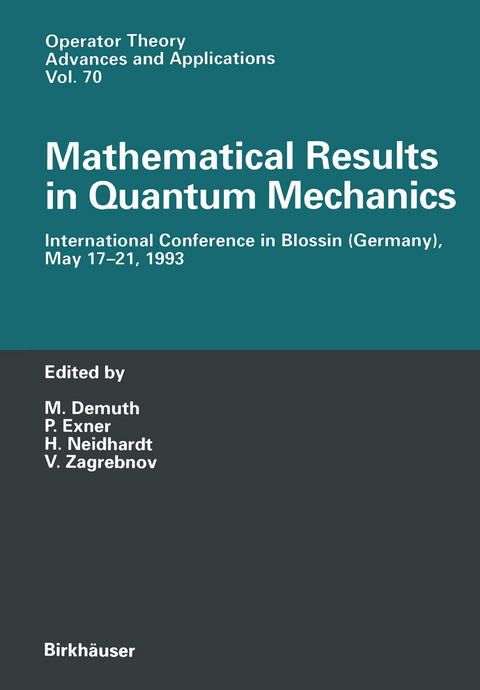
Mathematical Results in Quantum Mechanics
Springer Basel (Verlag)
978-3-0348-9673-3 (ISBN)
1 Schrödinger and Dirac operators.- Discrete spectrum of the periodic Schrödinger operator for non-negative perturbations.- The discrete spectrum in a gap of the continuous one for compact supported perturbations.- Schrödinger operators with strong local magnetic perturbations: Existence of eigenvalues in gaps of the essential spectrum.- Regularity of the nodal sets of solutions to Schrödinger equations.- Results in the spectral theory of Schrödinger operators with wide potential barriers.- Stark ladders and perturbation theory.- Singular potentials: algebraization.- Asymptotic behavior of the resolvent of the Dirac operator.- Discrete spectrum of the perturbed Dirac operator.- 2 Generalized Schrödinger operators.- The spectrum of Schrödinger operators in Lp(Rd) and in C0(Rd).- On spectral properties of generalized Schrödinger operators.- A Fermi-type rule for contact embedded-eigenvalue perturbations.- A simple model for predissociation.- Scattering on several solenoids.- Hall conductance of Riemann surfaces.- 3 Stochastic spectral analysis.- Framework and results of stochastic spectral analysis.- Occupation time asymptotics to the decay of eigenfunctions.- Holomorphic semigroups and Schrödinger equations.- Some problems on submarkovian semigroups.- Smoothness estimates and uniqueness for the Dirichlet operator.- Trace ideal properties of perturbed Dirichlet semigroups.- Quantum dynamical semigroups.- 4 Many-body problems and statistical physics K.B. Sinha.- Limits of infinite order, dimensionality or number of components for random finite-difference operators.- Atoms at finite density and temperature and the spectra of reduced density matrices.- Quantum fluctuations in the many-body problem.- General Hamiltonians and model Hamiltonians.- Poisson fieldsrepresentations in the statistical mechanics of conitinuous systems.- Exact ground states for quantum spin chains.- The spectrum of the spin-boson model.- A survey of Wigner-Poisson problems.- 5 Chaos.- Classical d'Alembert field in an one-dimensional pulsating region.- Irregular scattering in one-dimensional periodically driven systems.- Relatively random unitary operators.- 6 Operator theory and its application.- A trace formula for obstacles problems and applications.- Propagation in irregular optic fibres.- Singular perturbations, regularization and extension theory.- Adiabatic reduction theory. Semiclassical S-matrix for N-state one-dimensional systems.- The functional structure of the monodromy matrix for Harper's equation.- Eigenfunction expansion of right definite multiparameter problems.- Singularly perturbed operators.- Some problems of p-adic quantum theory.
| Erscheint lt. Verlag | 14.10.2012 |
|---|---|
| Reihe/Serie | Operator Theory: Advances and Applications |
| Zusatzinfo | X, 358 p. |
| Verlagsort | Basel |
| Sprache | englisch |
| Gewicht | 640 g |
| Themenwelt | Mathematik / Informatik ► Informatik ► Theorie / Studium |
| Mathematik / Informatik ► Mathematik | |
| Naturwissenschaften ► Physik / Astronomie ► Quantenphysik | |
| Naturwissenschaften ► Physik / Astronomie ► Theoretische Physik | |
| Naturwissenschaften ► Physik / Astronomie ► Thermodynamik | |
| Schlagworte | Analysis • Generator • operator theory • quantum mechanics • Quantum Physics • Statistica • Statistical Physics |
| ISBN-10 | 3-0348-9673-5 / 3034896735 |
| ISBN-13 | 978-3-0348-9673-3 / 9783034896733 |
| Zustand | Neuware |
| Haben Sie eine Frage zum Produkt? |
aus dem Bereich


